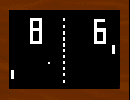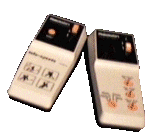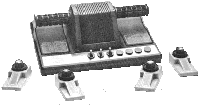Classic Home Videogames Museum: First Generation: Pong
Pong, Pong, and More Pong
 Many people who see this
screenshot will laugh. How can such a simple game provide any entertainment value?
Look at those horrible stick-like graphics! And those so-called sound effects--bleah!
That's what I thought (well, not in those exact words--"sucks" comes to mind) when I finally
got the first Pong-style system I owned, by Radofin, working. Since I began my obsession with
videogames when the Atari 2600 was king, I never even knew these systems existed.
Sure, I'd seen "Pong" in the Video Olympics cartridge for the 2600, but I never
thought anyone would make a whole system dedicated to one game. Little did I know, that
for its time, this unit was amazing.
Many people who see this
screenshot will laugh. How can such a simple game provide any entertainment value?
Look at those horrible stick-like graphics! And those so-called sound effects--bleah!
That's what I thought (well, not in those exact words--"sucks" comes to mind) when I finally
got the first Pong-style system I owned, by Radofin, working. Since I began my obsession with
videogames when the Atari 2600 was king, I never even knew these systems existed.
Sure, I'd seen "Pong" in the Video Olympics cartridge for the 2600, but I never
thought anyone would make a whole system dedicated to one game. Little did I know, that
for its time, this unit was amazing.
 I began to play it. The sliders were a bit jumpy at first, but only due to
years of neglect--a few minutes of "wear-in" had them working well. Maybe this system
was no longer amazing to anyone, but it became addictive. It was so simple: move the
paddle (the "big blip") to hit the ball (the "little blip"). I tried to put myself
into the mindset of the original owner who bought the system "way-back-when."
Wow, I can control pictures on my TV screen! Wait until my friends see this!
So my friends came over, and we played it for a while. And it was fun, for a while.
Then the fun wore off, just as it did for most owners of these systems, and we
went back to playing Atari 2600 games.
I began to play it. The sliders were a bit jumpy at first, but only due to
years of neglect--a few minutes of "wear-in" had them working well. Maybe this system
was no longer amazing to anyone, but it became addictive. It was so simple: move the
paddle (the "big blip") to hit the ball (the "little blip"). I tried to put myself
into the mindset of the original owner who bought the system "way-back-when."
Wow, I can control pictures on my TV screen! Wait until my friends see this!
So my friends came over, and we played it for a while. And it was fun, for a while.
Then the fun wore off, just as it did for most owners of these systems, and we
went back to playing Atari 2600 games.
 The very first home video game system was the Odyssey [picture courtesy of Matt Brady] of 1972 which,
while simple graphically, used overlays and interchangable cartridges. The
cartridges were simply jumper sets to choose games on the system and
did not actually contain program ROMs. The dedicated pong-style systems
mentioned above came next (a flood of them starting 1975), and were mildly
popular.
The very first home video game system was the Odyssey [picture courtesy of Matt Brady] of 1972 which,
while simple graphically, used overlays and interchangable cartridges. The
cartridges were simply jumper sets to choose games on the system and
did not actually contain program ROMs. The dedicated pong-style systems
mentioned above came next (a flood of them starting 1975), and were mildly
popular.
There were many attempts to build a better mousetrap--err, a better ball-and-paddle system.
For example, the first systems like the Atari Pong unit are all one piece, but later
models spawned off separate controls, such as the Radio Shack
TV Scoreboard.
Eventually, the interesting permutations ran out and game producers scrambled to
come out with more games per unit. At the left is the Sears Telegames IV.
Not only did it support four-player b&p games,
in color,
but it included handlebar grips on the unit to control a motorcycle in a game called
Stunt Cycle.
Coleco, producer of many dedicated ball-and-paddle systems, introduced the
Telstar Arcade. It used interchangeable
cartridges, but like the original Odyssey unit,
these cartridges
did not contain ROM programs but rather a simple set of jumpers to make
different games on the main unit.
Producers saw that the life
of single-game game units was very short, but even multi-game units still lacked
a key component: expandability.
Pictures
[PREV]
[UP]
[NEXT]
Dennis Brown, dgbrown (at) pixesthesia (dot) com,
creator and maintainer. E-Mail me with corrections and additions.
All contents copyright 2006, Dennis Brown. All trademarks are properties
of their respective companies.
 Many people who see this
screenshot will laugh. How can such a simple game provide any entertainment value?
Look at those horrible stick-like graphics! And those so-called sound effects--bleah!
That's what I thought (well, not in those exact words--"sucks" comes to mind) when I finally
got the first Pong-style system I owned, by Radofin, working. Since I began my obsession with
videogames when the Atari 2600 was king, I never even knew these systems existed.
Sure, I'd seen "Pong" in the Video Olympics cartridge for the 2600, but I never
thought anyone would make a whole system dedicated to one game. Little did I know, that
for its time, this unit was amazing.
Many people who see this
screenshot will laugh. How can such a simple game provide any entertainment value?
Look at those horrible stick-like graphics! And those so-called sound effects--bleah!
That's what I thought (well, not in those exact words--"sucks" comes to mind) when I finally
got the first Pong-style system I owned, by Radofin, working. Since I began my obsession with
videogames when the Atari 2600 was king, I never even knew these systems existed.
Sure, I'd seen "Pong" in the Video Olympics cartridge for the 2600, but I never
thought anyone would make a whole system dedicated to one game. Little did I know, that
for its time, this unit was amazing.
 I began to play it. The sliders were a bit jumpy at first, but only due to
years of neglect--a few minutes of "wear-in" had them working well. Maybe this system
was no longer amazing to anyone, but it became addictive. It was so simple: move the
paddle (the "big blip") to hit the ball (the "little blip"). I tried to put myself
into the mindset of the original owner who bought the system "way-back-when."
Wow, I can control pictures on my TV screen! Wait until my friends see this!
So my friends came over, and we played it for a while. And it was fun, for a while.
Then the fun wore off, just as it did for most owners of these systems, and we
went back to playing Atari 2600 games.
I began to play it. The sliders were a bit jumpy at first, but only due to
years of neglect--a few minutes of "wear-in" had them working well. Maybe this system
was no longer amazing to anyone, but it became addictive. It was so simple: move the
paddle (the "big blip") to hit the ball (the "little blip"). I tried to put myself
into the mindset of the original owner who bought the system "way-back-when."
Wow, I can control pictures on my TV screen! Wait until my friends see this!
So my friends came over, and we played it for a while. And it was fun, for a while.
Then the fun wore off, just as it did for most owners of these systems, and we
went back to playing Atari 2600 games.
 The very first home video game system was the
The very first home video game system was the